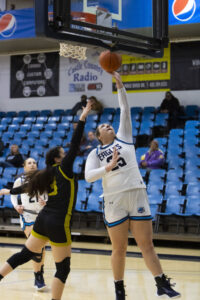State auditors find problems with CEU record keeping
This archived article was written by: Cj Jelsma
The state of Utah’s Office of the State Auditor recently completed its audit of the College of Eastern Utah’s business practices along with a federal compliance audit for the previous year.
The audit, which covers the time period of July 1, 2003 to June 30, 2004, focused on weaknesses and problems that CEU had with its financial reporting during the time period.
The audit noted certain matters that were considered to be reportable conditions. This includes significant deficiencies in CEU’s control over financial reporting.
The first finding of the audit was that CEU did not record 49 journal entries into the college’s accounting system until after the audit was finalized. It was also noted that none of the entries were reviewed by anyone other than the individual that prepared the statement.
Another finding of the audit was that for the past few years at CEU, the accounting department has been understaffed in comparison to other colleges of similar size. The audit recommended that CEU staff the accounting department adequately to ensure that functions are performed properly and in a timely manner.
The audit also noted that of 19 departments, 10 did not review on a regular basis the Banner financial reports for funds and accounts for which they are responsible. It was recommended that all departments review their Banner financial reports relevant to their responsible areas.
The college also had weaknesses in its separation of duties stated the audit. This occurs when the same individual has custody of assets, access to the accounting records and/or collection responsibilities.
The audit also stated that during the review of net asset balances with fund deficits greater than $20,000, nine areas had a deficit at the end of the fiscal year.
During the review of capital assets, it was noted that in six instances, the college was not in compliance with their capital asset policy and procedure.
It was also discovered that CEU and the Southeast Applied Technology College process their transactions through the same bank account even though the SEATC is a separate legal entity.
The college also had not collected enough building and rental fees for the Burtenshaw Hall Dorms to cover the dorm’s maintenance and operating expenses and 125 percent of the fiscal year 2005 debt service requirement. The required amount to meet the bond is $200,515 while CEU only collected $194,317.
The audit also stated that early retirees for the fiscal year of 2004 were recorded as qualifying for more benefits than their early retirement contracts allowed.
During the review of inventory at CEU’s San Juan Center’s bookstore, it was noted that two of 25 inventory items tested did not agree with the number of items recorded on the inventory system.
Three of the current services contracts tested by the auditor did not have a formal, signed contract between the college and service provider. Bid quotes obtained from the winning bidder were used to support charges for services performed on contract.
Of the personnel files for several employees reviewed, it was noted that neither of the two files tested for full-time staff members had a current annual evaluation, the most recent evaluation being fiscal year 2000. CEU’s policies and procedures state that full-time staff and faculty are required to receive employee evaluations annually.
The auditor also performed a surprise count of the petty cash fund at the Price purchasing office in March 2005 and noted that the fund was short $131.58. There were also two vouchers, one for $37.97 from 1999 and one for $100 from 1997, where money was advanced but no receipt or money was returned.
It was also stated that there were three individuals with access to the petty cash fund. Having this many individuals with access to the fund makes it difficult for the custodian to be held responsible for any discrepancies within the fund.
The final finding of the audit was that there was an unauthorized petty cash fund at the College of Eastern Utah’s Prehistoric Museum that contained $127.52. This fund was not recorded in the college’s accounting system but has existed for at least 10 years.
The college concurred with all of the audit’s findings and in many cases has established means to solve the problems.
Raelene Allred, vice president of finance and administrative services, was contacted for a quote on the audit, but did not respond.




